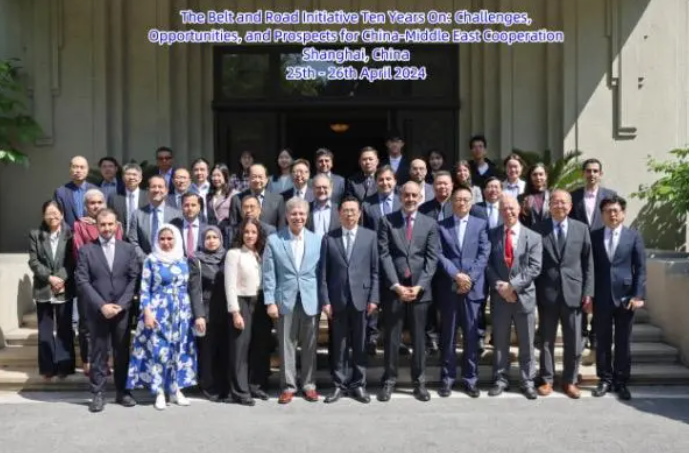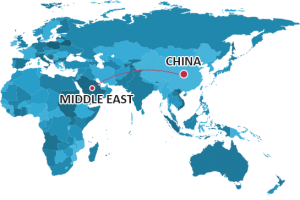Be your Logistics Department in China
Customized logistics solutions, your logistics expert in China
Customized logistics solutions, Shipping from China to the World
Tel:+8613424475220 Email:info@viputrans.com 
Economic cooperation between China and the Middle East under the background of “One Belt, One Road”
From April 25 to 26, 2024, the international symposium "The Tenth Anniversary of the Belt and Road Initiative: Challenges, Opportunities and Prospects for Cooperation between China and the Middle East" was held in Shanghai. This seminar was jointly sponsored by the Shanghai Academy of Social Sciences and the Qatar Middle East Council for Global Affairs, and hosted by the Institute of International Studies of the Shanghai Academy of Social Sciences. This is also the third in a series of international seminars on the theme of cooperation between China and the Middle East under the framework of the “One Belt, One Road” initiative. The first two sessions were held in Shanghai and Doha in 2018 and 2019 respectively.

China is the Middle East's largest trading partner, and the Middle East is China's most important energy supplier. As the joint construction of the "Belt and Road" initiative continues to advance, in addition to traditional energy infrastructure cooperation, the two sides have also continued to innovate in cooperation in green economy, digital economy, Silk Road e-commerce, agricultural cooperation, people-to-people exchanges and other fields.
The Middle East connects the three continents of Asia, Africa and Europe, strangles the transportation hub of the eastern and western hemispheres, and connects the transportation network at the eastern and western ends of the Eurasian continent. It is located at the intersection of the “One Belt, One Road” initiative. The Middle East is known as the "World's Oil Depot", accounting for more than half of the world's proven oil reserves and about a quarter of the world's total oil production. Fifteen Middle Eastern countries and regions, including Iran, Iraq, Israel, Turkey, Jordan, Kuwait, Lebanon, Oman, Qatar, Saudi Arabia, Bahrain, Syria, Palestine, the United Arab Emirates and Egypt, are located along the “Belt and Road”. At present, China and Middle Eastern countries have established cooperative relationships to varying degrees in the fields of international trade, direct investment, infrastructure construction, and cross-border use of RMB, which mainly exhibit four major characteristics.
1. Economic and trade exchanges are frequent and highly complementary.
Since ancient times, China and the Middle East have maintained close economic and trade exchanges through the "Silk Road". In recent years, with the advancement and implementation of China’s all-round diplomacy and the “One Belt, One Road” initiative, China and Middle Eastern countries have signed a number of agreements in the fields of economy, culture, science and technology, and infrastructure construction, and the pace of bilateral economic and trade cooperation has continued to accelerate. In terms of trade scale, China is currently not only Iran's largest trading partner and Turkey's second largest trading partner, but also the largest trading partner of nine Arab countries and the second largest trading partner in the entire Arab region, as well as an important crude oil export market.
2. Mutual investment between China and Middle Eastern countries is becoming increasingly active.
Since the launch of the Belt and Road Initiative, the UAE has actively participated in the initiative due to its development potential, strategic location and pioneering economic role in the region. Data for the first half of 2023 show that the non-oil trade volume between the UAE and the countries co-building the "Belt and Road" reached US$305 billion, accounting for 90% of the UAE's total non-oil trade during the same period, an increase of more than 13% from the first half of 2022.
3. Cooperation in infrastructure construction heats up
China actively promotes the construction of the “One Belt, One Road” initiative and took the lead in establishing the Asian Infrastructure Investment Bank and the Silk Road Fund. The purpose is to help countries along the route accelerate infrastructure construction and promote regional economic development. The investment direction of the AIIB and Silk Road Fund is medium and long-term projects of strategic significance, including infrastructure, resource development, industrial cooperation and financial cooperation. In November 2014, China and Qatar signed a "Belt and Road" cooperation document, which will expand mutually beneficial cooperation between the two parties in infrastructure construction and high-tech fields, especially transportation, roads and bridges, railways, and telecommunications. In the Middle East, Chinese companies have also undertaken infrastructure projects such as the East-West Corridor in Qatar, quayside bridges, and the Mesaied Natural Gas Industrial Park, and have undertaken transportation construction projects such as the Mecca Light Rail Railway in Saudi Arabia. They are technically and cost-competitive. Cooperation in the field of infrastructure has achieved good social benefits and good economic benefits.
4. Government cooperation mechanism promotes RMB local settlement.
In order to facilitate cross-border trade settlement and bilateral economic cooperation, the Chinese government began to promote the internationalization of the RMB in 2009. Middle Eastern countries are important economic and trade partners of China. Driven by government cooperation mechanisms, the region's cross-border use of RMB, product innovation and the construction of offshore clearing centers have developed rapidly in recent years. In 2012 and 2014, in order to better provide guarantee for promoting bilateral trade, China signed bilateral local currency swap agreements worth an equivalent of 35 billion yuan with the United Arab Emirates and Qatar. In 2015, China established a RMB clearing center in Doha, the capital of Qatar, to further promote the development of RMB trade and investment facilitation in regions along the “One Belt, One Road” initiative. After the opening of the Doha RMB clearing center for trading, Qatar relied on its influence in the Middle East and its ability to carry out professional commercial transactions in the fields of currency clearing, trade finance, asset and wealth management, and financial services to meet the RMB needs of customers in the Middle East and Africa. played an important role.
The current situation of trade between China and Middle Eastern countries
In 2022, the trade volume between China and Middle Eastern countries will reach US$507.152 billion, a year-on-year increase of 27.1%. After hitting a new high of 35.7% growth in 2021, China's trade with Middle Eastern countries continues to maintain high levels and rapid growth. In the first three months, the bilateral trade volume between China and countries in the Middle East and West Asia reached 102.178 billion U.S. dollars, surpassing the trade with countries along the “Belt and Road” in Europe for the first time, and the proportion increased by nearly 1 percentage point compared with the same period last year. Among them, China’s Regional countries exported US$44.615 billion and imported US$57.562 billion.
China is the largest trading partner in the Middle East, mainly exporting mechanical and electrical products, textiles, home appliances and toys. The Middle East is China's most important energy supplier, accounting for half of China's crude oil imports for a long time. In December last year, Yiwu and Saudi Arabia completed the first cross-border RMB payment business, which has become a vivid case.
The two sides have continued to deepen cooperation in high-tech fields such as 5G, artificial intelligence, new energy, and aerospace satellites. China has successfully launched artificial satellites for Algeria, Saudi Arabia, and Sudan, established the first overseas center of the Beidou satellite navigation system in Tunisia, and established a joint renewable energy laboratory with Egypt.
What are the shipping options from China to the Middle East?

Shipping from China to the Middle East:
Less than Container Load (LCL): Less than Container Load (LCL) allows your shipment to share a container with another shipper’s shipment. You only pay for the space your goods take up, which is very cost-effective for small quantities.
Full Container Load (FCL): Full Container Loading involves leasing and shipping a dedicated container for your shipment. It may be more economical, especially for large and heavy cargo.
Air freight from China to the Middle East:
If you need to urgently ship your products to the Middle East, air freight is the fastest option. However, it may come with a higher price tag.
Shipping costs from China to the Middle East:
Freight charges vary depending on factors such as the nature of the goods, mode of transportation, volume, dimensions and weight of the consigned goods. Generally speaking, for goods under 100 kilograms, air freight is more economical and provides faster delivery. For heavier shipments that are not urgent and exceed 100kg, sea freight is usually more cost-effective.
Shipping time from China to the Middle East:
Your shipping deadline will affect your choice between air and ocean shipping. Air freight is faster. A direct flight only takes one day to reach the country you want to go, and a transfer flight only takes 3-5 days to arrive, but the cost is higher. Ocean shipping takes longer, usually between 18 and 38 days, but is more economical.
Track sea shipments from China to the Middle East:
Customers can track the transportation status of the goods online through the air waybill number or the ocean bill of lading number/container number.
If you have any question about shipping goods from China to Middle East please feel free to consult Viputrans Lora Yang E-mail: sales02@viputrans.com
SKYPE|WECHAT|WHATSAPP|MOB:+86 13424468029
VIPU SUPPLY CHAIN LOGISTICS CO.,LTD
Copyright © 2003-2025 VIPU Supply Chain Logistics Co., Ltd. | All Rights Reserved
LOGISTICS | E-COMMERCIAL FULFILLMENT | ABOUT US | CASE | NEWS | VIDEO | CONTACT US
We will find the fastest or the cheapest way for your shipment. Please specify: where from, where to, what to ship.